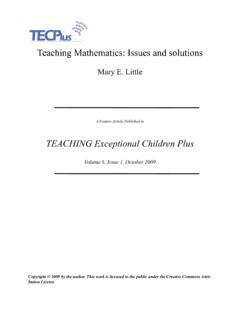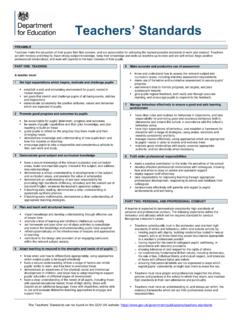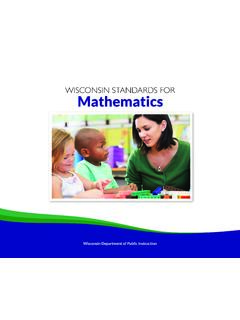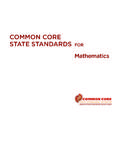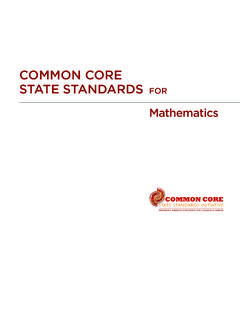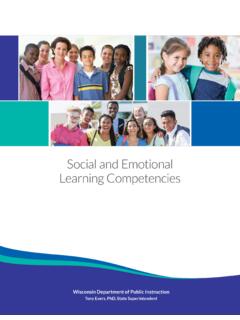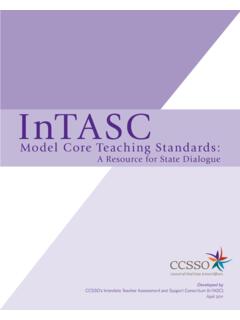Transcription of Concrete Materials and Teaching for Mathematical ...
1 Concrete Materials and Teaching for Mathematical Understanding Patrick W. ThompsonCenter for Research in mathematics and Science EducationSan Diego State UniversityRunning Head: Concrete MaterialsP. W. Thompson, Concrete Materials and Teaching for mathematicalunderstanding, Arithmetic Teacher 41(9) (1994) 556-558. Preparation of this paper was supported by National Science Foundation GrantsNo. MDR 89-50311 and 90-96275, and by a grant of equipment from AppleComputer, Inc., Office of External Research. Any conclusions orrecommendations stated here are those of the author and do not necessarily reflectofficial positions of NSF or Apple Materials -1 Learning without thought is labor lost. ConfuciusAn experience is not a true experience until it is reflective. John DeweyToday there seems to be common agreement that effective mathematicsinstruction in the elementary grades incorporates liberal use of Concrete in The Arithmetic Teacher no longer exhort us to use concretematerials, nor did the professional standards for Teaching mathematics (National Council of Teachers of mathematics 1991) include a standard on theuse of Concrete Materials .
2 The use of Concrete Materials seems to be aim in this article is to reflect on the role of Concrete Materials inteaching for Mathematical understanding, not to argue against their use, butinstead to argue for using them more judiciously and reflectively. Our primaryquestion should always be, What, in principle, do I want my students tounderstand? It is too often, What shall I have my students learn to do. If wecan only answer the second question, then we have not given sufficient thoughtto what we hope to achieve by a particular segment of instruction or use ofconcrete on the Use of Concrete MaterialsThe use of Concrete Materials has always been intuitively appealing. Theeditors of a turn-of-the-century methods text stated, Examples in the Concrete arebetter for the student at this stage of his development, as he can more readilycomprehend these (Beecher and Faxon 1918, p.)
3 47, as quoted in ; McKillip andThompsonConcrete Materials -2others 1978). Their appearance accelerated in 1960 s, at least in the UnitedStates, with the publication of theoretical justifications for their use by ZoltonDienes (1960) and by Jerome Bruner (1961).A number of studies on the effectiveness of using Concrete Materials havebeen conducted since Dienes and Bruner s publications, and the results aremixed. Fennema (1972) argued for their use with beginning learners whilemaintaining that older learners would not necessarily benefit from them. Suydamand Higgins (1977) reported a pattern of beneficial results for all (1985) described the considerable difficulties had by his study smiddle and upper primary students in making sense of base-ten blocks. Fusonand Briars (1990) reported astounding success in the use of base-ten blocks inteaching addition and subtraction algorithms.
4 Thompson (1992) and Resnick andOmanson (1987) reported that using base-ten blocks had little effect on upper-primary students' understanding or use of their already-memorized whole-number addition and subtraction algorithms. Wearne and Hiebert (Hiebert,Wearne et al. 1991) report consistent success in the use of Concrete Materials toaid students understanding of decimal fractions and decimal apparent contradictions probably are due to aspects of instruction andstudents engagement to which studies did not attend. Evidently, just usingconcrete Materials is not enough to guarantee success. We must look at the totalinstructional environment to understand effective use of concretematerials especially teachers images of what they intend to teach and students images of the activities in which they are asked to Materials -3 Seeing Mathematical Ideas in Concrete MaterialsIt is often thought, for example, that an actual wooden base-ten cube ismore Concrete to students than is a picture of a wooden base-ten cube.
5 As objectsthis certainly seems true. But to students who are still constructing concepts ofnumeration, the thousand-ness of a wooden base-ten cube often is no moreconcrete than the thousand-ness of a pictured cube (Labinowicz 1985). Tounderstand the cube (either actual or pictured) as representing a numerical valueof one thousand, students need to create an image of a cube that entails itsrelations to its potential parts ( , that it can be made of 10 blocks each having avalue of one hundred, 100 blocks each having a value of ten, or 1000 blocks eachhaving a value of one). If their image of a cube is simply as a big block named thousand, then there is no substantive difference to students between a pictureof a cube or an actual cube the issue of concreteness would be immaterial totheir understanding of base-ten numeration. This is not to say that, to students,there is never a substantive difference between pictures and actual , it says only that Concrete Materials do not automatically carrymathematical meaning for students.
6 There can be a substantive differencebetween how students experience actual Materials and how they experiencedepictions of Materials , but the difference resides in how they are used. I willreturn to this see Mathematical ideas in Concrete Materials can be challenging. Thematerial may be Concrete , but the idea you intend that students see is not in thematerial. The idea you want your students to see is in the way you understand thematerial and in the way you understand your actions with it. Perhaps twoThompsonConcrete Materials -4examples will illustrate this common approach to Teaching fractions is to have students consider acollection of objects, some of which are distinct from the rest, as depicted inFigure 1. The collection depicted in Figure 1 is certainly Concrete . But, whatmight it illustrate to students? Three circles out of five? If so, they see a part and awhole, but not a fraction.
7 Three-fifths of one? Perhaps. But depending on howthey think of the circles and collections, they could also see three-fifths of five, orfive-thirds of one, or five-thirds of three (see Figure 2).Figure 1. What does this collection illustrate?They could also see Figure 1 as illustrating that 1 35=123 that withinone whole there is one three-fifths and two-thirds of another three-fifths, or that5 3=123 that within 5 is one 3 and two-thirds of another 3. Finally, theycould see Figure 1 as illustrating 53 35=1 that five-thirds of (three-fifths of 1)is 1. It is an error to think that a particular material or illustration, by itself,presents an idea unequivocally. mathematics , like beauty, is in the eye of thebeholder and the eye sees what the mind Materials -5If we see as one collection, then is one-fifth of one, so is three-fifths we see as one collection, then isone-third of one, so is five-thirdsof we see as one circle, then is fivecircles, so is one-fifth of five, and isthree-fifths of we see as one circle, then is threecircles, so is one-third of three, and is five-thirds of 2.
8 Various ways to think about the circles and collections in Figure sometimes understand the discussion of Figure 1 (and Figure 2)as saying that we need to take care that students form correct interpretations ofmaterials namely, the one we intend they have. I actually mean the opposite. Itshould be our instructional goal that students can make, in principle, allinterpretations of Figure teacher needs to be aware of multiple interpretations of Materials in orderto hear hints of those which students actually make. Without this awareness it iseasy to presume that students see what we intend they see, and communicationbetween teacher and student can break down when students see something otherthan what we , it is important that students can create multiple interpretations ofmaterials. They are empowered when they recognize the multiplicity ofThompsonConcrete Materials -6viewpoints from which valid interpretations can be made, for they are then alert tochose among them for the most appropriate relative to a current , it is a teacher s responsibility to cultivate this view.
9 It probably will nothappen if the teacher is unaware of multiple interpretations or thinks that the ideasare there in the 1 is customarily offered by texts and by teachers to illustrate In fact, we rarely find texts or teachers discussing the difference betweenthinking of 35 as three out of five and thinking of it as three one-fifths. Howa student understands Figure 1 in relation to the fraction 35 can have tremendousconsequences. When students think of fractions as so many out of so many they are justified in being puzzled about fractions like 65. How do you take sixthings out of five?My second example continues the discussion of fractions. It illustrates thathow we think of the Materials in a situation can have implications for how wemay think about our actions with , in Figure 3, that the top collection is an example of 35 and thebottom collection is an example of 34.
10 Now, combine the two collections. Doesthe combined collection provide an example of 35+34? Yes and no. If we werethinking of 3/5 and 3/4 as ratios (so many out of every so many), then35+34=69 (three out of every five combined with three out of every fourgives six out of every nine, as when computing batting averages). If weunderstood 35 and 34 in Figure 3 as fractions, then it doesn t make sense to talkabout combining them. It would be like asking, If we combine 35 of a largepizza and 34 of a small pizza, then how much of a pizza do we have? HowThompsonConcrete Materials -7much of which kind of pizza? It only makes sense to combine amounts measuredas fractions when both are measured in a common unit. Both answers (69 and the question doesn t make sense ) are correct each in regard to a particular wayof understanding the Concrete material at the 3.
